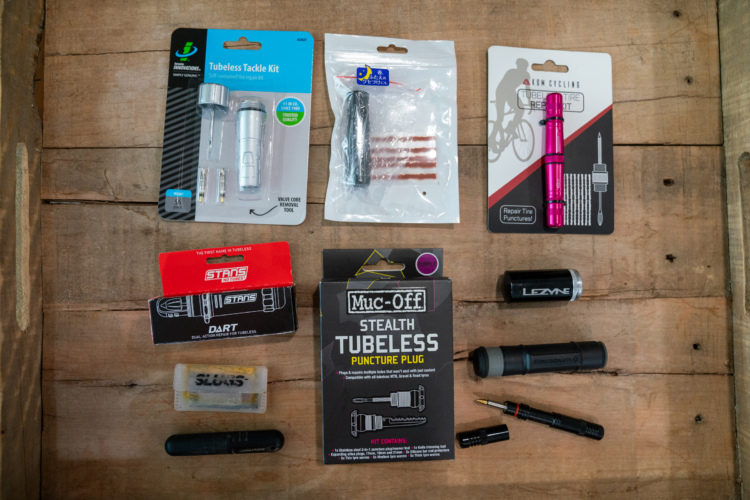
If you’ve been mountain biking with tubeless tires for any length of time, you know sealant isn’t a cure-all for punctures. For larger holes, or even tiny ones that won’t seal for whatever reason, there’s a simple, convenient solution: tire plugs.
What is a tire plug?
A bike tire plug is basically just a two-inch strip of rubber designed to be inserted into a tire puncture. The idea is that the plug fills the hole just enough for sealant to do its work, while remaining flexible enough to roll with the tire. Unfortunately tire plugs are not designed to seal holes in a tube so if you’re running tubes, look into patches instead.
Mountain bike tire plugs are generally sticky on the outside, so they tend to be stored between two sheets of plastic film to keep them moist and to prevent the plugs from getting stuck to items in your pack. The rubber is irregular and often wavy to help the strip stay in place. Tire plugs of varying thicknesses can be used to seal holes of varying sizes, though a medium-sized plug should fill most holes riders will encounter.

Tire plug tools are basically fat needles with a sharp tip and a mechanism for holding the plug. They’re generally small and lightweight, often with plug storage within the tool itself.
How to use tubeless bike tire plugs
Imagine this: You’re riding along on your tubeless mountain bike tires with two ounces of fresh sealant when you accidentally veer into a thorny cactus (or blackberry bush) on the side of the trail. Sealant immediately starts spewing out of a hole in your front tire. You slam on the brakes, jump off your bike, and lift the wheel off the ground, spinning the hole to the 6 o’clock position so the sealant can do its job. Except, the tire sealant just keeps shooting out.
Without tire plugs, the best you can do is keep shaking the tire around and hoping the remaining fluid will seal the puncture. If you’re carrying tire plugs and a tool, don’t just sit around and watch! Put a finger over the hole to prevent any more sealant and air pressure from escaping, and grab your plug kit.
Step one: Thread the plug


Thread a plug into your tool. For the Ryder Slug Plug shown in the photos above, thread either a small or large plug (depending on the size of the hole) through the eye of the tool. With other tools, like the Blackburn Plugger Tubeless Tire Repair kit shown below, insert one end of the plug into the inside of the needle itself. With either one, you’ll want to position the plug so it’s held in place at its middle.

If you’re using a tool like the Ryder Slug Plug, you’ll want to fold the plug up a bit as shown in the photo below. For a tool like the one from Blackburn, stick the free end of the plug to the side of the needle.
Step two: Find the hole, and insert the tool

Tire plugs only work if you’re plugging the actual hole, and not just a spot nearby. This sounds obvious, but finding the puncture can be difficult in some cases, particularly if your tire is dry and there’s no sealant leaking out. Use your ears to hone in on the spot, then spray some water from a bottle or your hydration hose around the area and look for bubbles to pinpoint the exact spot.

Once you’ve identified the hole, insert the tool. As you can see from the photos of these tools, the needles are generally pretty stout (they’re not for sewing thread after all) and it will take a good bit of force to get them all the way through the tire. Having a decent amount of pressure in the tire makes it easier as you’ll have something to push against.

Insert the plug until it’s about halfway through its folded length, leaving a good bit of the plug exposed. If you insert the plug too far it may just drop inside your tire which doesn’t help. With the plug inserted the tool should slide out, leaving the plug in place.
Step three: Inflate your tire
Chances are some air has seeped out during this process so be sure to air up your tire before you roll away. If you’re carrying extra sealant, this could be a good time to add some more, though in my experience a plug, even in a dry tire, tends to do a good job sealing the puncture by itself.
Keep in mind that if you allow all the air to leak out of your tire following the initial puncture, there’s a good chance the tire bead will become unseated. In this case, it may be difficult, if not impossible to re-seat the tubeless tire with a mini-pump. If you have a CO2 inflator, now is the time to use it. Otherwise, do whatever you can to keep some amount of air in the tire while you’re inserting the plug to avoid an unsealed bead.
Step four: Ride on!

The cool thing about using tire plugs is they allow riders to fix a puncture without having to take the wheel off, which definitely saves time. Can I keep riding with a plug in my tire? Yes! You can generally ride on the plugged tire indefinitely without the need to make a more permanent repair at home. In the past my go-to trailside tubeless tire repair method involved throwing in a tube, which meant futzing with the tire again at home to go back to tubeless.
Can I use a tire plug on a sidewall puncture?
Sometimes! It’s always worth a try, especially when the alternative is a long walk back to the car. Thicker plugs tend to work best, or you may want to insert a few plugs in case of a slit. Because of the way sidewalls flex, a tire boot, along with a tube, may offer a better solution.
Two tubeless tire plug tools

I’ve tried the Ryder Slug Plug and Blackburn Plugger Tubeless Tire Repair kit, and both perform well.

The Ryder kit is smaller and lighter than the Blackburn kit at 19.3g vs. 27.4g. However, the Blackburn kit does have a spot within the tool to store plugs which helps keep things organized. A frame strap is included with the Blackburn kit, adding additional weight, but saves pack space if that’s important for you. The hole in the end of the Ryder tool works as a Presta valve core remover.

Ryder includes about a dozen plugs in two different sizes, while the Blackburn kit comes with about the same number of plugs in just a single size. Pricing is $10 for the Ryder kit and $20 for the Blackburn kit. Most tire plugs are cross-compatible with tools from other manufacturers, and replacement packs are available for about $5.





















3 Comments
May 28, 2019
May 22, 2023
Oct 20, 2019